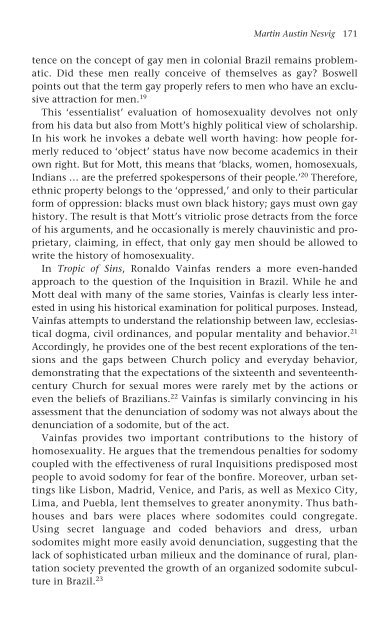queer masculinities
queer masculinities
queer masculinities
You also want an ePaper? Increase the reach of your titles
YUMPU automatically turns print PDFs into web optimized ePapers that Google loves.
tence on the concept of gay men in colonial Brazil remains problematic.<br />
Did these men really conceive of themselves as gay? Boswell<br />
points out that the term gay properly refers to men who have an exclusive<br />
attraction for men. 19<br />
This ‘essentialist’ evaluation of homosexuality devolves not only<br />
from his data but also from Mott’s highly political view of scholarship.<br />
In his work he invokes a debate well worth having: how people formerly<br />
reduced to ‘object’ status have now become academics in their<br />
own right. But for Mott, this means that ‘blacks, women, homosexuals,<br />
Indians … are the preferred spokespersons of their people.’ 20 Therefore,<br />
ethnic property belongs to the ‘oppressed,’ and only to their particular<br />
form of oppression: blacks must own black history; gays must own gay<br />
history. The result is that Mott’s vitriolic prose detracts from the force<br />
of his arguments, and he occasionally is merely chauvinistic and proprietary,<br />
claiming, in effect, that only gay men should be allowed to<br />
write the history of homosexuality.<br />
In Tropic of Sins, Ronaldo Vainfas renders a more even-handed<br />
approach to the question of the Inquisition in Brazil. While he and<br />
Mott deal with many of the same stories, Vainfas is clearly less interested<br />
in using his historical examination for political purposes. Instead,<br />
Vainfas attempts to understand the relationship between law, ecclesiastical<br />
dogma, civil ordinances, and popular mentality and behavior. 21<br />
Accordingly, he provides one of the best recent explorations of the tensions<br />
and the gaps between Church policy and everyday behavior,<br />
demonstrating that the expectations of the sixteenth and seventeenthcentury<br />
Church for sexual mores were rarely met by the actions or<br />
even the beliefs of Brazilians. 22 Vainfas is similarly convincing in his<br />
assessment that the denunciation of sodomy was not always about the<br />
denunciation of a sodomite, but of the act.<br />
Vainfas provides two important contributions to the history of<br />
homosexuality. He argues that the tremendous penalties for sodomy<br />
coupled with the effectiveness of rural Inquisitions predisposed most<br />
people to avoid sodomy for fear of the bonfire. Moreover, urban settings<br />
like Lisbon, Madrid, Venice, and Paris, as well as Mexico City,<br />
Lima, and Puebla, lent themselves to greater anonymity. Thus bathhouses<br />
and bars were places where sodomites could congregate.<br />
Using secret language and coded behaviors and dress, urban<br />
sodomites might more easily avoid denunciation, suggesting that the<br />
lack of sophisticated urban milieux and the dominance of rural, plantation<br />
society prevented the growth of an organized sodomite subculture<br />
in Brazil. 23 Martin Austin Nesvig 171


